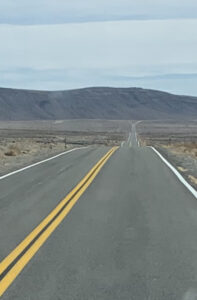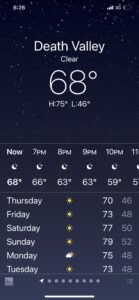#8 Death Valley to Las Vegas
Death Valley:
Summer temperatures reach over 130 degrees, average rainfall 2 inches annually: an endless expanse of rocks and gravel and as far as you can see. Death Valley is all that is left of Lake Manley, the body of water that once covered it thousands of years ago. Much of the Valley exists below sea level. This National Park lies on the border of California and Nevada and it’s sparsely traveled roads are marked with melted tourists’ tire tracks and warning signs to bring water and wear protective clothing.
But we are visiting Death Valley in February, not August, and for us it is a welcome sun break; warm days, cool nights. We park our van at a campground that looks like a parking lot. Heck, it IS a parking lot, not counting the picnic tables. But that’s ok, it has everything we need. The sunsets over the mountains are transcendent, the stars infinite. The silence and the vast space make sunrise and sunset times to consider eternity.
This is where the 20 Mule Train carried carts of the mineral Borate out of strange mustard colored hills to make the cleaning agent called Borax. This is where desperate pioneers on the California trail killed their oxen and chopped up their wagons for firewood to cook them. This is where prospectors during the Gold Rush in 1849 died to find Gold. The 49ers (not the football team) really busted themselves up here, and still made no visible scar on the landscape.
Rhyolite, named for the igneous rock that resembles granite, is a ghost town on the outskirts of the valley. In 1906 Rhyolite the town had as many as 8,000 citizens, and supported an Opera House, a bank, three railway depots, a stock exchange, and an ice cream parlor run by a countess from Europe. 5 years later it was abandoned. (The ruins we visited reminded me of the Shelley’s romantic poem Ozymadius.
https://www.poetryfoundation.org/poems/46565/ozymandias
Mind you, before white men ever arrived here, indigenous people lived on what was available, presumably without the drama. The Timbisha Shoshone Tribe have a reservation inside the Park today.
When James was not working we hiked volcano craters, canyons and peaks exploring this crazy landscape of exposed rock and mineral. Why didn’t I study mineralogy? Titus Canyon has the vertiginous feel of midtown Manhattan; Immense rock cliffs tower above you as you walk down a wash of multicolored gravel. The canyon holds an abandoned 150-year-old miners‘ camp, where the miners searched fruitlessly for gold, leaving rude holes in the mountains and raw ugly mine tailings below. It also contains ancient petroglyphs, pecked delicately into the rock by ancestors of the Timbisha Shoshone, marking a magical spot where water still rises from the rocky soil into a marsh of tender green grass.
At night the campground hummed: caravans of families (homeschooling?) bikers, hippies with hanging laundry, campfires and guitars, huge shiny RVs with gleaming trucks sporting American flags to tow them. Some looked like they were there for awhile. We met an older couple who have been “full timers” for 4 years. They volunteer for the park service and have traveled through every part of Mexico. People in Sprinter vans like ours stopped to compare details from a distance.
After 5 fun-filled days we ascended from Death Valley and returned to the world of the living. A few hours East in Nevada, Ash Meadows National Wildlife Refuge was very much alive.
https://www.fws.gov/refuge/ash_meadows/
Plants, animals, birds of every kind all thrive there thanks to a turquoise thermal spring bubbling up in the colorful meadow. This area is the ancestral sacred home of the local tribe and you can see why. It is enchanting. The area is thoughtfully presented in all its complexity by a federally-funded visitors center (closed) and artful boardwalks and signage. But it wasn’t always this way.
Ash Meadows had been stripped by the irrigation of alfalfa farms and ranching concerns. The developers moved in 1980 and “Calvada City” was planned; a mini Las Vegas with shopping malls and casinos. “Lake Calvada” was being bulldozed out of the turquoise spring when they met an unlikely, but powerful one-inch long opponent, the pupfish. The tiny pupfish is a fossil ancestor of the bigger fish that once lived in the aforementioned, now evaporated, Lake Manley. It has adapted to 92 degree water, and has lived it’s fishy life in the underground fossil water left to it. The pupfish became the very first animal protected by the Endangered Species Act. In it’s day saving the pupfish was as controversial as the spotted owl in Oregon. We inspected the cave-like home of the “Devils Hole” pupfish. The cave it lives in was completely covered by a huge metal cage and surrounded by security cameras. Apparently the local population still holds a grudge: a group of discontents had tried to kill them. What a crazy country we live in, in which we need to protect a one-inch fish from marauding humans.
While seeing the sites of Ash Meadows we met Ko Blix, an artist from Berkeley and his moving piece of public art.. an SUV retrofitted into an act of protest. (See photo). We had thought our rig cool until we saw his. I particularly appreciated his poster of Picasso’s Guernica on the back.
Traveling East we drove the strip of the huge water-sucking travesty that is the city of Las Vegas. Due to Covid the strip is looking like a pale shadow of what we saw in 2004. Maybe it will all come back. I hope so, for the sake of the huge, ever-growing population. Hopefully those Covid checks are coming through for all the out-of-work support staff. The city has been sucking the water out of the Colorado river for decades while co-opting large tracts of desert for housing.
Quickly moving past Las Vegas we are now camped now at a beautiful National Park Campsite, Willow Beach, AZ, a few miles below Lake Mead and Hoover Dam on the Colorado river. Yesterday we took advantage, renting a canoe from the Park service and paddling through the emerald waters of Black Canyon.
All of this is makes me feel we were lucky to get this van. These middle-aged teenagers might never come home. Thanks for reading, and stay safe.
Julia
Goodbye Sierras………….Down into Death Valley. And further down.
Yessssssssssss: read Blog #7 to understand why this is SO great.
The Sandunes at sea level
Badwater Basin
Texas Springs Campground: below: zoom call
Ubehebe Crater
Petroglyph by a spring
Ash Meadows wildlife preserve home of the endangered Pupfish
Ko Blix and his moving protest bus
Las Vegas: almost empty
Caeser’s Palace and the housing stock surrounding the city, built into the desert.

































Recent Comments